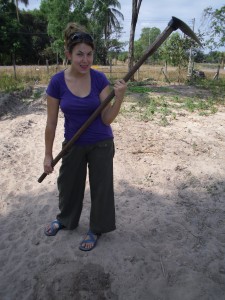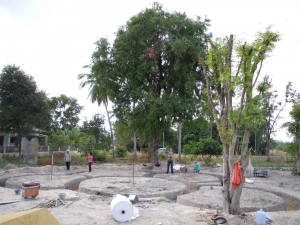My first introduction to the concept of building with unprocessed materials was in the miserly Mr. Grahms 4th grade class at Meadowlark Elementary. All Campbell County 4th graders study Wyoming history. The Great Plains of the U.S. were a tough place before infrastructure. It pleased me to pieces to know many pioneer families lived in dugout homes — as in: a hole dug into a hillside with a sod roof. No, I wasn’t gloating about their rough luck: I was inspired! “If all it takes to build a house is a shovel, I could build my own house! Right now!” thought my 10-year-old brain.
Fast-forward to my years on the west coast, and I slowly discovered other building methods that didn’t require fat pallets of lumber, gargantuan loads of drywall, and an endless supply of concrete. Of recent memory are the infamous “Straw Bale Cafe on the 199” and the “Toolshed at CCAT.” However, they both kind of struck me as hippie art projects. Sure you can build a structure out of straw and clay and mud. But no one was living in these buildings. And let’s be honest. We all know instinctively that building your house from dirt and dead plants is at best a waste of money and at worst an invitation for tragedy.

Infamous on the 199 between Willow Creek and Weaverville. Obviously someone undaunted by modern building conventions is similarly unphased by conventional exterior paint choices.
Well, friends, it’s easy to denounce the unfamiliar from the soapbox of ignorance. In a stroke of luck last spring, while WWOOFing with a ‘cityslickers-move-to-the-country’ couple who thought none too highly of their neighbor’s straw bale house, we were invited over to said house alone one afternoon for coffee.
The second I stepped through the door I thought, “I want a house like this.” I’d venture the feeling of walking into that house for me was the same sensation you get when you’ve been househunting for months and you finally find The One. You just know.
I think we stayed for three hours, absorbing every step of the process we could. We plied our host with question after question, and one by one she defended every (gently phrased) criticism we could think of. I researched her claim about the longevity of these types of structures. She was right. They don’t yet know how long straw-bale houses last. Not because it’s some sort of new-fangled hippie thing. Because the oldest buildings haven’t failed in over 200 years. 1I see the possible ‘reasoning hole’ here: “Surely its simple to keep track of houses still standing and easy to erase those that failed from history.” Yes, surely. However, I’ll argue that the expected life span for track homes going up in the suburbs these days is 50 years if the glass if half empty, and 100 if it is half full. And one doesn’t have to look far to find mainstream houses constructed just a few decades ago that have fallen into complete ruin. Hopefully if I achieve my straw bale dreams I will join the icons, not be washed away in the rain.

A little too heavy on the “white” for me, but nonetheless this photo showcases just how classy and swank straw bale homes can feel.
Straw bales aren’t the only way to get a house out of affordable, widely-available building materials. Just ask the Anasazi, whose cliff dwelling structures are still intact in Colorado’s Mesa Verde National Park after enduring for over 700 years. Mud bricks, cobb (straw, clay, sand mixture), bamboo, rammed earth, earth bags, and combinations of the latter are among the options. And if any of them feel like a straw bale house feels, I’m willing to listen! Our straw-bale afternoon came near the end of our New Zealand tour, and unfortunately it didn’t pan out to see any of the other alternative homes in the country.
Imagine my excitement then, when a friend’s friend 2whom I immediately adored told me he was going to Thailand 3from the Philippines at the beginning of January to help build an earth bag house. “But I’M going to Thailand in January! And I’m fascinated by this ‘alternative building’ scene! Can I come, too?!”
Eivind from Norway gave me the contact info for an ex-Californian who was following the earth bag method promoted by Cal-Earth with his Thai wife in isolated Northeastern Thailand (where a ‘farang’ — white foreigner — is a rare sight). Five months ago, after three years of romance kindled on the streets of San Francisco, they’d decided to move their lives to her home country. Now the blueprints for their self-designed home are coming to life.
Our delayed arrival coincided perfectly with the delayed start of the project. To my chagrin, Eivind, for whom I have an impractical degree of adoration, had disappeared a week or two before when he arrived to find the building was decidedly not under way.
For the first two days, Pat and I spent the day shoveling sand into a garden cart, wheeling it to the main pile, and dumping it. Not very interesting work in the hot tropical sun, but we did get a sense for how the site was laid out, what had been done so far, and what the plan was moving forward. We even watched a 45-minute how-to video.

I became intimately familiar with the ways of moving dirt using rudimentary tools while not further damaging my ankle.
Finally the hired-builder and his crew arrived. The first building day, we were very productive. The steps for this type of construction are as follows:
- Dig circular trenches about 2 feet deep.
- Pour concrete at the bottom to create a solid foundation.
- Fill “earth bags” – essentially the same material used for sand bags, but left in tube form instead of cut into tiny bags. The bag tubes are filled with a tested mix of sand, clay, dirt, and cement.
- Tamp or pound earth bags until solid.
- Once a layer is complete, lay down two strands of barbed wire to act as “velcro” and add another layer.
- At about four feet, use a simple but precise dual compass method to slowly and evenly bring in the layers to create a dome — one of the strongest shapes in the world.
I have to say right away that the dome shape doesn’t appeal to me. Mine is a world of angles, and I have no aspirations to change that. However, both Pat and I are very curious about all the options in this alternative building world. And we wouldn’t mind a funky dome as a guest space. After the first day filling bags by running two teams of three, opportunities for participation slowed to a crawl. Eivind came back on Sunday — a week after we arrived. We spent Monday shoveling piles and then finally participating in building again. That night, Pat and I re-evaluated our personal and travel goals and decided it was time to head for warmer waters. Goodbye and good luck, little earth bag home! ♣
More site photos, candid moments on the job, and a tamarind tree experience can be viewed here.
The cultural side of this experience is coming in the next post!
References
| ↑1 | I see the possible ‘reasoning hole’ here: “Surely its simple to keep track of houses still standing and easy to erase those that failed from history.” Yes, surely. However, I’ll argue that the expected life span for track homes going up in the suburbs these days is 50 years if the glass if half empty, and 100 if it is half full. And one doesn’t have to look far to find mainstream houses constructed just a few decades ago that have fallen into complete ruin. Hopefully if I achieve my straw bale dreams I will join the icons, not be washed away in the rain. |
|---|---|
| ↑2 | whom I immediately adored |
| ↑3 | from the Philippines |







I am glad that you liked my straw bale design. That straw bale house (interior picture) featured is a house I designed in San Diego, CA.
Awesome! Loved getting to see more photos of the place – fantastic design! May straw bale homes proliferate 🙂
Hey Jema,
Your Great Aunt Shelia build a straw bale restaurant in Thermopolis which is still there. You should check it out and visit with her and Dave about how they built it. They live in Cottonwood, Arizona….about a 4 hour drive from Tucson.
That’s awesome! I had no idea. She’s not on FB is she? I’ll look for her.
That’s a cool story sis!!! I hope that if you travel back by there you take a pic so we can see the finished product!!
Love
Jeana
p.s. Izziah got the postcard pic of the zoo!!!
Glad you liked it, Beaner. I am hoping to get back there, and I will share a finished product pic with you on FB. Check out Robert Gepford’s wall – find him in my “Friends.” He’s got an album of the construction (it’s his house).
Glad the postcard arrived! They’re getting faster and faster!